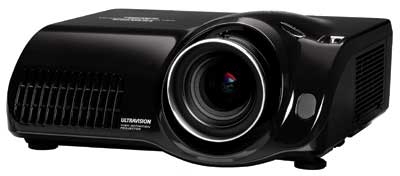Shootout: Eight Budget HDTV Projectors Page 3

Hitachi HDPJ52
| The Short Form |
| $2,300 ($3,500 list) / 14.3 x 5.8 x 11.8 IN / 10.4 lbs / hitachi.us / 800-448-2244 |
| Plus |
| •Good blacks •Lens-shift control |
| Minus |
| •Screen-door effect •Some image softness |
| Key Features |
| •1,280 x 720-pixel LCD Projector •Inputs 1 HDMI; 1 component-video; 1 S-video, 1 composite-video; 1 RGB/VGA; 1 RS-232C control •PRICE $2,300 ($3,500 List) Full Lab Results |
CONTRAST LCD technology has come a long way toward producing a convincing black, and that quest is aided in the Hitachi by a valuable mechanical iris control. I adjusted it to coax a relatively inky black out of scenes in the shadowy corners of The Island's murky Tech Services department - though turning it down any further to get the very deepest blacks just made the image too dim for my large screen size and prevented me from achieving my target brightness. This projector is probably best suited to a screen smaller than 80 inches.
COLOR After calibration, the Hitachi's grays were a bit less consistent than those of most of the other projectors. In particular, it became a little red in the middle of its brightness range - a tint that was visible in the light gray ceiling of The Island's lab, for example. Primary colors were pretty accurate, with the exception of green. In a direct comparison with the more accurate Samsung, for instance, an illustration seen in an elevator looked a bit yellow.
DETAIL LCD projectors are known for "screen door" effect in which the grid lines between pixels can become apparent at normal viewing distances. While this was certainly more subtle on the Hitachi HDPJ52 than I've seen on some other LCD projectors, the many white fields in The Island made it more obvious than with any of the other projectors in the test. For instance, when Lincoln passed by a backlit "Department of Labor" placard, the white looked slightly grainy, and when I moved closer, the grain resolved into the fine grid of pixels. Despite a sharp look overall, I did notice that tiny details on the right side of the screen - Jordan's blonde hair as she leaned over a pregnant lady, for example - seemed softer, an apparent fault with the lens. HD scenes from the ESPN SportsCenter studio also didn't have the same razor quality as on, say, the InFocus or the Optoma.
- Log in or register to post comments




















































